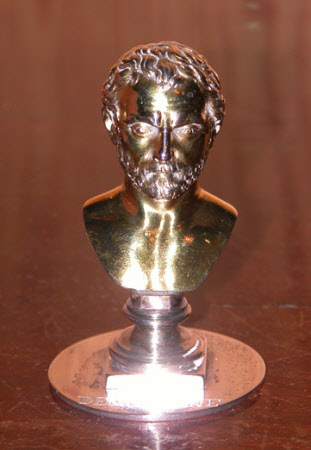Demosthenes (c.384-322 B.C.)
Italian School
Category
Art / Sculpture
Date
c. 1750 - 1800
Materials
Silver-gilt
Measurements
518 x 338 mm; 477 mm (Diameter)
Place of origin
Italy
Order this imageCollection
Anglesey Abbey, Cambridgeshire
NT 517629
Summary
Silver-gilt, Demosthenes (c. 384-322 B.C.), Italian School, c. 1750-1800. A silver-gilt bust of the Athenian orator Demosthenes, head and shoulders, bearded, looking slightly to his left. Mounted on a separately cast silver waisted socle on a broad circular base plate, inscribed DEMOSTANE. A pair to a similar bust of Cicero (NT 517628).
Full description
By the eighteenth century, Demosthenes and Cicero, had come to be regarded as the greatest orators of the ancient Greek and Roman worlds respectively. Demosthenes (c. 384-322 B.C.) was the greatest Athenian orator, whose career was largely built around his opposition to the attempts by king Philip of Macedon to dominate the rest of Greece, including Athens. Many stories were told of Demosthenes’ struggles against a speech impediment, a weak voice and a stumbling delivery. He cured his stammering by speaking with pebbles in his mouth, he strengthened his voice by running uphill declaiming verses from the poets and accustomed himself to the noise of public assemblies by declaiming on the seashore. Of around sixty orations by Demosthenes that have survived, the best-known are his Philippics, attacks on the Macedonian king and his ambitions. Like Cicero, Demosthenes met a violent end, killing himself with poison after the failure of an uprising by the Greek states that broke out on the death in 323 B.C. of Philip’s son Alexander the Great. Like Cicero, Demosthenes was restored to fame during the Renaissance period and became especially popular in the eighteenth century, when he was an inspiration for the revolutionary movements in America and in France. The silver bust is based on the standard image of Demosthenes, which derives from a statue by the sculptor Polyeuktos, set up on the Agora in Athens in 280 BC. It does not survive, but provided the model for around fifty surviving Roman copies of his image, which shows the orator bearded, his brows furrowed in concentration. Demosthenes and Cicero were often portrayed together. They can for example be seen, along with the modern writers Francis Bacon and Sir Philip Sidney, on the engraved title page to The Academy of Eloquence by Thomas Blount, published in 1654 (example in National Portrait Gallery, NPG D25389). By the eighteenth century, the two men had come to be regarded as the greatest orators of the ancient Greek and Roman worlds respectively, so pairs of portraits of Demosthenes and Cicero became even commoner. These tiny bust portraits were probably made in Italy, principally no doubt with the tourist market in mind. Jeremy Warren 2020
Provenance
Bequeathed to the National Trust by Huttleston Rogers Broughton, 1st Lord Fairhaven (1896-1966) with the house and the rest of the contents.
Credit line
Anglesey Abbey, The Fairhaven Collection (National Trust)
Marks and inscriptions
On base plate: DEMOSTANE
Makers and roles
Italian School, sculptor
